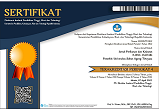The Addition of Flour Kappaphycus alvarezii in Commercial Feed towards Tilapia (Oreochromis niloticus) Performance
Abstract
Tilapia (Oreochromis niloticus) is one of fish that is suitable to be cultivated in floating net cages or in controlled containers, since tilapia is the omnivorous and is easily adjust to the environment. An artificial feeding in an intensive farming is one of the important supporting factor to increase production. Natural feed available could not meet the needs of fish, therefore in order to promote growth, it must be fulfilled by the artificial feed that could qualify nutrition. The research aims to observing the dose addition of flour Kappaphycus alvarezii in commercial feed to enhance the growth and the survival of O. niloticus. The usability of the research is the costs efficiency of feed and provides information on aspects of tilapia fish farming. The result of the research shows that daily specific growth rate performs that control treatment (0.94±0.14%) gives the best growth response compared to the treatment of seaweed flour 20% (0.06±0.04%), then is followed by the treatment of seaweed flour 5% (0.52±0.17). Further research statistic peforms that the control is significantly different to the treatment of seaweed flour 20% (p<0.05). For the best feed convertion ratio is in control (0.31±0.02) and the lowest is in the treatment of seaweed flour 20% (0.45±0.03). Then the best survival is in control treatment (80.00±0.00%), followed by treatment of seaweed flour 5% (76.670±0.00%) and the lowest survival is in treatment of seaweed flour 20% (63.33±0.06%).
Keywords
feed, flour Kappaphycus alvarezii, growth, tilapia (Oreochromis niloticus)
Full Text:
PDFDOI: http://dx.doi.org/10.33512/jpk.v5i2.1063
Refbacks
- There are currently no refbacks.



_-_Copy1.png)